Monitoring Atmospheric Atomic Mercury by Optical Techniques
Abstract
1. Introduction
2. Optical Techniques for Atomic Mercury Monitoring
2.1. Introduction
2.2. The Atomic Mercury 6s6p 3P1 - 6s2 1S0 Transition Close to 254 nm
2.3. In Situ/Point Monitoring
2.3.1. Absorption Approach
2.3.2. Fluorescence Approach
2.3.3. Correlation Approach
2.4. Remote Sensing
2.4.1. Long-Path Optical Absorption
2.4.2. Differential Absorption Lidar (DIAL)
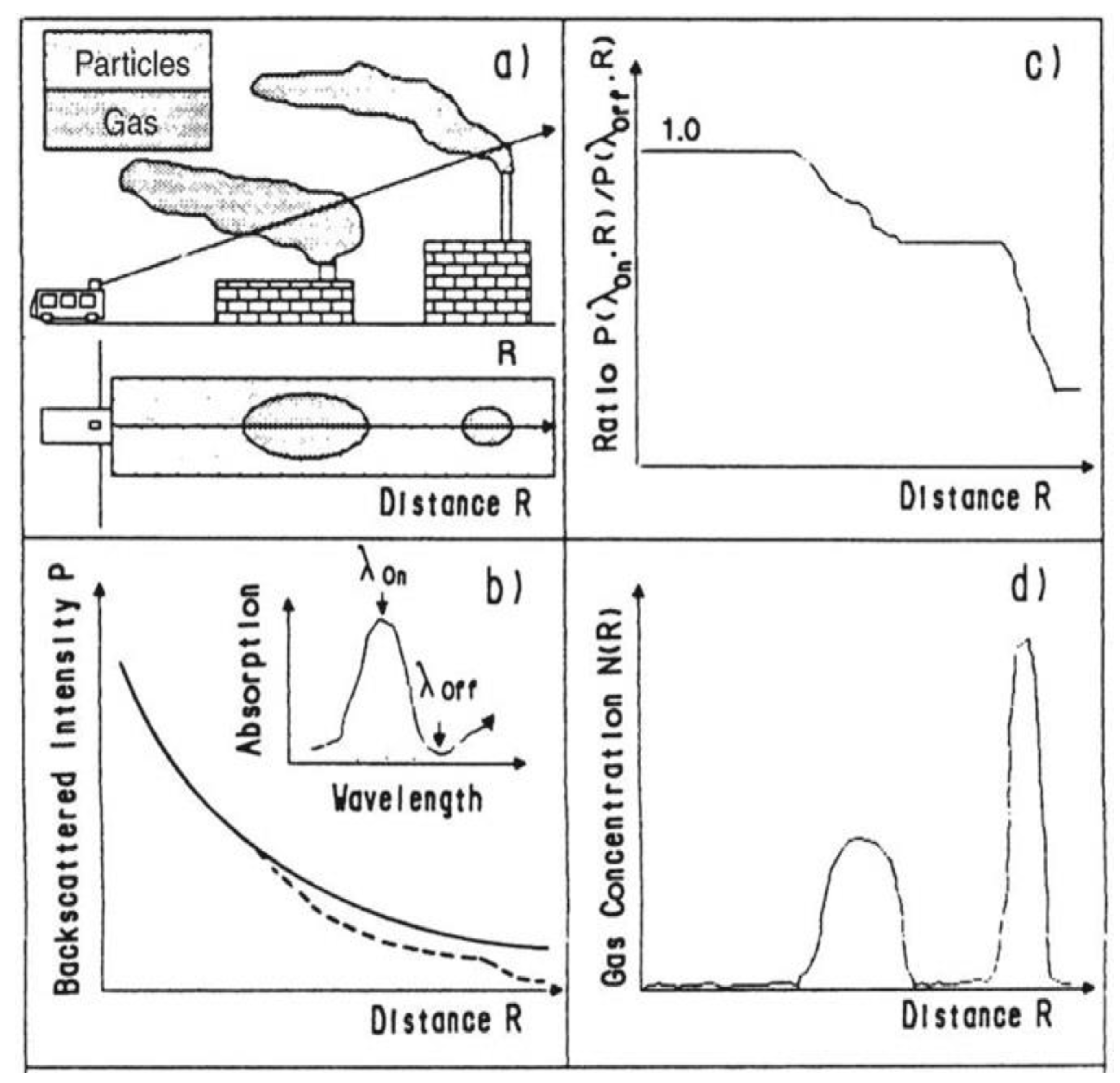
3. Atomic Mercury Monitoring
3.1. Clean Air Monitoring
3.2. City Monitoring
3.3. Industrial Monitoring

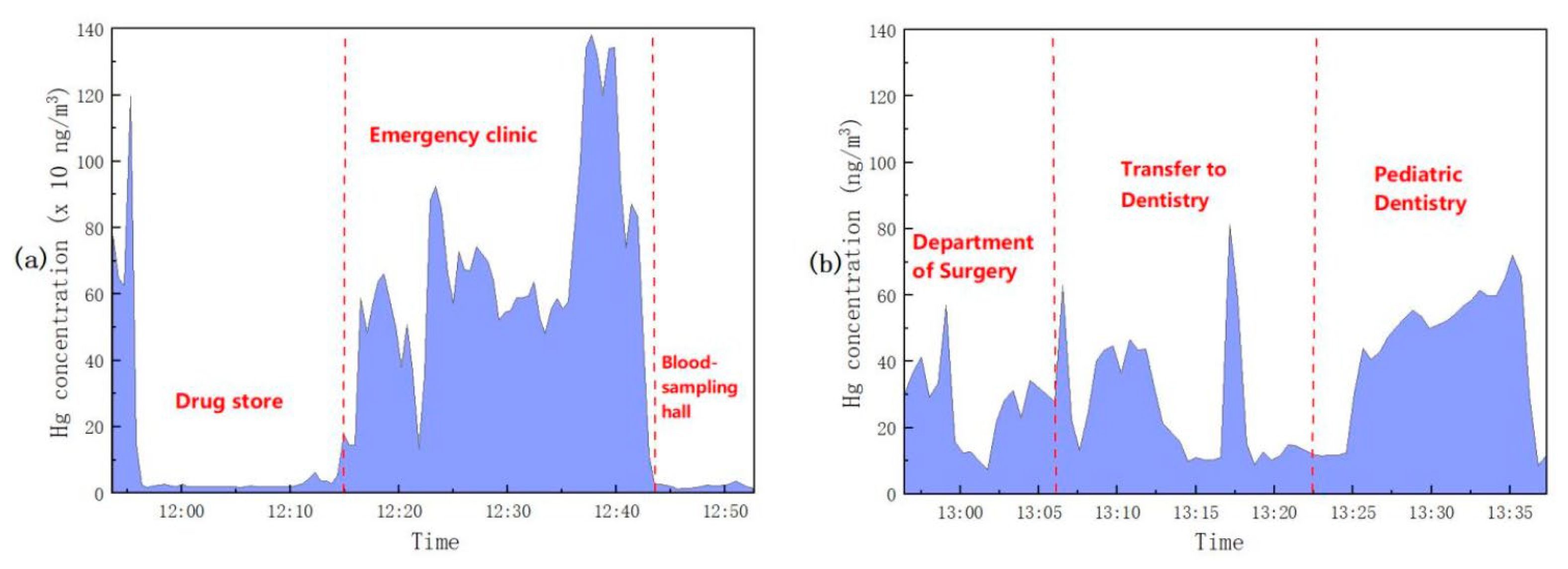
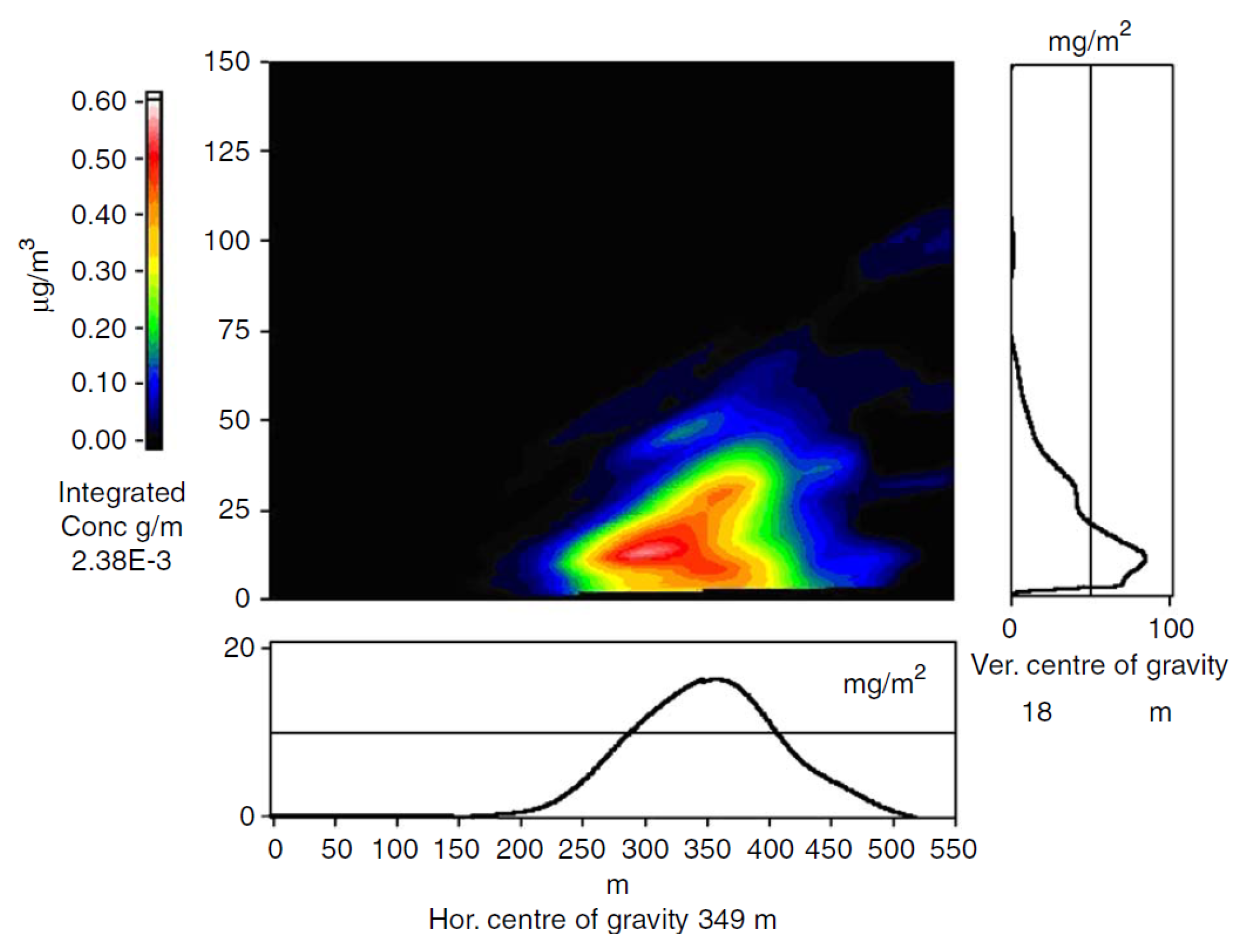
3.4. Geophysical Monitoring
3.4.1. Geothermal Fields
3.4.2. Volcanoes
3.4.3. Mercury Mining Areas
3.5. Archeological Monitoring
4. Conclusions
Funding
Institutional Review Board Statement
Informed Consent Statement
Data Availability Statement
Acknowledgments
Conflicts of Interest
References
- Liu, G.; Cai, Y.; O’Driscoll, N.; Feng, X.; Jiang, G. Overview of mercury in the environment. In Environmental Chemistry and Toxicology of Mercury; Wiley: Hoboken, NJ, USA, 2012; pp. 1–12. [Google Scholar]
- Beckers, F.; Rinklebe, J. Cycling of mercury in the environment: Sources, fate, and human health implications: A review. Crit. Rev. Environ. Sci. Technol. 2017, 47, 693–794. [Google Scholar] [CrossRef]
- European Community DG Environment, Science for Environmental Policy. Tackling Mercury Pollution in the EU and WORLDWIDE. In-Depth Report 15. 2017. Available online: http://ec.europa.eu/science-environment-policy (accessed on 29 June 2023).
- UNEP. Global Mercury: Supply, Trade and Demand. 2017. Available online: http://wedocs.unep.org/bitstream/handle/20.500.11822/21725/global_mercury.pdf?sequence=1&isAllowed=y (accessed on 29 June 2023).
- Sass, B.M.; Salem, M.A.; Smith, L.A. Mercury Usage and Alternatives in the Electrical and Electronics Industries. Final Report; Battelle: Columbus, OH, USA, 1994. [Google Scholar]
- Mazzolai, B.; Mattioli, V.; Raffa, V.; Tripoli, G.; Dario, P.; Ferrara, R.; Lanzilotta, E.; Munthe, J.; Wängberg, I.; Barregård, L.; et al. A multidisciplinary approach to study the impact of mercury pollution on human health and environment: The EMECAP project. RMZ-Mater. Geoenviron. 2004, 51, 682. [Google Scholar]
- Billings, C.E.; Matson, W.R. Mercury emission from coal combustion. Science 1972, 176, 1232–1233. [Google Scholar] [CrossRef] [PubMed]
- Esdaile, L.J.; Chalker, J.M. The mercury problem in artisanal and small-scale gold mining. Chem. Eur. J. 2018, 24, 6905–6916. [Google Scholar] [CrossRef] [PubMed]
- Bakir, F.; Damluji, S.F.; Amin-Zaki, L.; Murtadha, M.; Khalidi, A.; al-Rawi, N.Y.; Tikriti, S.; Dahahir, H.I.; Clarkson, T.W.; Smith, J.C.; et al. Methylmercury poisoning in Iraq. Science 1973, 181, 239–241. [Google Scholar] [CrossRef]
- Harada, M. Minamata Disease: Methylmercury poisoning in Japan caused by environmental pollution. Crit. Rev. Toxicol. 1995, 25, 1–24. [Google Scholar] [CrossRef]
- United Nations. Minamata Convention on Mercury. 2013. Available online: http://www.mercuryconvention.org/Portals/11/documents/Booklets/Minamata%20Convention%20on%20Mercury_booklet_English.pdf (accessed on 29 June 2023).
- ICMGP. International Conference on Mercury as a Global Pollutant, with the Latest Version (15th) Arranged in 2022. Available online: https://www.ilmexhibitions.com/mercury2022/conference-programme (accessed on 29 June 2023).
- Pacyna, E.G.; Pacyna, J.M.; Sundseth, K.; Munthe, J.; Kindbom, K.; Wilson, S.; Steenhuisen, F.; Maxson, P. Global emission of mercury to the atmosphere from anthropogenic sources in 2005 and projections to 2020. Atmos. Environ. 2010, 44, 2487–2499. [Google Scholar] [CrossRef]
- Streets, D.G.; Horowitz, H.M.; Jacob, D.J.; Lu, Z.; Levin, L.; ter Schure, A.F.H.; Sunderland, E.M. Total mercury released to the environment by human activities. Environ. Sci. Technol. 2017, 51, 5969–5977. [Google Scholar] [CrossRef]
- Streets, D.G.; Hao, J.; Wu, Y.; Jiang, J.; Chan, M.; Tian, H.; Feng, X. Anthropogenic mercury emissions in China. Atmos. Environ. 2005, 39, 7789–7806. [Google Scholar] [CrossRef]
- Morel, F.M.; Kraepiel, A.M.; Amyot, M. The chemical cycle and bioaccumulation of mercury. Annu. Rev. Ecol. Syst. 1998, 29, 543–566. [Google Scholar] [CrossRef]
- Lin, C.J.; Singhasuk, P.; Pehkonen, S.O. Atmospheric chemistry of mercury. Environ. Chem. Toxicol. Mercury 2012, 4, 113–153. [Google Scholar]
- Feng, X.B. Mercury pollution in China—An overview. In Dynamics of Mercury Pollution on Regional and Global Scales; Pirrone, N., Mahaffey, K.R., Eds.; Springer: Norwell, MA, USA, 2005; pp. 657–678. [Google Scholar]
- Fu, X.; Feng, X.; Wang, S.; Rothenberg, S.; Shang, L.H.; Li, Z.; Qiu, G. Temporal and spatial distributions of total gaseous mercury concentrations in ambient air in a mountainous area in southwestern China: Implications for industrial and domestic mercury emissions in remote areas in China. Sci. Total Environ. 2009, 407, 2306–2314. [Google Scholar] [CrossRef]
- Fu, X.; Feng, X.; Sommar, J.; Wang, S. A review of studies on atmospheric mercury in China. Sci. Total Environ. 2012, 421, 73–81. [Google Scholar] [CrossRef]
- Wängberg, I.; Munthe, J.; Pirrone, N.; Iverfeldt, Å.; Bahlman, E.; Costa, P.; Ebinghaus, R.; Feng, X.; Ferrara, R.; Gårdfeldt, K.; et al. Atmospheric mercury distribution in Northern Europe and in the Mediterranean region. Atmos. Environ. 2001, 35, 3019–3025. [Google Scholar] [CrossRef]
- Travnikov, O. Atmospheric Transport of Mercury. In Environmental Chemistry and Toxicology of Mercury; Liu, G., Cai, Y., O’Driscoll, N., Eds.; John Wiley & Sons, Inc.: Hoboken, NJ, USA, 2012; pp. 331–365. [Google Scholar]
- Díez, S. Human health effects of methylmercury exposure. Rev. Environ. Contam. Toxicol. 2008, 198, 111–132. [Google Scholar]
- Mergler, D.; Anderson, H.A.; Chan, L.H.M.; Mahaffey, K.R.; Murray, M.; Sakamoto, M.; Stern, A.H. Methylmercury exposure and health effects in humans: A worldwide concern. AMBIO J. Hum. Environ. 2007, 36, 3–11. [Google Scholar] [CrossRef]
- Committee on Toxicological Effects of Methylmercury; National Research Council of the United States; National Academies of Science. Toxicological Effects of Methylmercury; National Academies Press: Washington, DC, USA, 2000.
- Pandey, S.K.; Kim, K.-H.; Brown, R.J.C. Measurement techniques for mercury species in ambient air. Trends Anal. Chem. 2011, 30, 899–917. [Google Scholar] [CrossRef]
- Liu, N.; Qiu, G.; Landis, M.S.; Feng, X.; Fu, X.; Shang, L.H. Atmospheric mercury species measured in Guiyang, Guizhou province, southwest China. Atmos. Res. 2011, 100, 93–102. [Google Scholar] [CrossRef]
- Ciani, F.; Rimondi, V.; Costagliola, P. Atmospheric mercury pollution: The current methodological framework outlined by environmental legislation. Air Qual. Atmos. Health 2021, 14, 1633–1645. [Google Scholar] [CrossRef]
- Svanberg, S. Atomic and Molecular Spectroscopy: Basic Aspects and Practical Applications. In Graduate Texts in Physics, 5th ed.; Springer: Berlin/Heidelberg, Germany, 2023. [Google Scholar]
- Thorne, A.; Litzén, U.; Johansson, S. Spectrophysics; Springer: Berlin/Heidelberg, Germany, 1999. [Google Scholar]
- Rodhuner, E. Optical Spectroscopy—Fundamentals and Advanced Applications; World Scientific: Singapore, 2018. [Google Scholar]
- Demtröder, W. Laser Spectroscopy, 4th ed.; Volume 1: Basic Principles; Volume 2: Experimental Techniques; Springer: Berlin/Heidelberg, Germany, 2008. [Google Scholar]
- Gravina, S.; Clivati, C.; Castrillo, A.; Fasci, E.; Chrishti, N.S.; Galzerano, G.; Levi, F.; Gianfrani, L. Measurement of the mercury (6s6p) 3P1-state lifetime in the frequency domain from integrated absorbance data. Phys. Rev. Res. 2022, 4, 033240. [Google Scholar] [CrossRef]
- Alnis, J.; Gustafsson, U.; Somesfalean, G.; Svanberg, S. Sum-frequency generation with a blue diode laser for mercury spectroscopy at 254 nm. Appl. Phys. Lett. 2000, 76, 1234–1236. [Google Scholar] [CrossRef]
- Anderson, T.N.; Magnuson, J.K.; Lucht, R.P. Diode-laser-based sensor for ultraviolet absorption measurements of atomic mercury. Appl. Phys. B 2007, 87, 341–353. [Google Scholar] [CrossRef]
- Magnuson, J.K.; Anderson, T.N.; Lucht, R.P.; Vijayasarathy, U.A.; Oh, H.; Annamalai, K.; Caton, J.A. Application of a diode-laser-based ultraviolet absorption sensor for in situ measurements of atomic mercury in coal-combustion exhaust. Energy Fuels 2008, 22, 3029–3036. [Google Scholar] [CrossRef]
- Guan, Z.G.; Lundin, P.; Mei, L.; Somesfalean, G.; Svanberg, S. Vertical lidar sounding of air pollutants in a major Chinese city. Appl. Phys. B 2010, 101, 465–471. [Google Scholar] [CrossRef]
- Mei, L.; Zhao, G.; Svanberg, S. Differential absorption lidar system employed for background atomic mercury vertical profiling in South China. Opt. Lasers Eng. 2014, 55, 128–135. [Google Scholar] [CrossRef]
- Wang, Z.; Chen, Z.; Ning, D.; Zhang, X. Gaseous elemental mercury concentration in atmosphere at urban and remote sites in China. J. Environ. Sci. 2007, 19, 176–180. [Google Scholar] [CrossRef]
- Ferrara, R.; Seritti, A.; Barghigiani, C.; Petrosino, A. Improved instrument for mercury determination by atomic fluorescence spectrometry with a high-frequency electrodeless discharge lamp. Anal. Chem. Acta 1980, 117, 391. [Google Scholar] [CrossRef]
- Hamilton, D.M.; Varey, H.R.; Millan, M.M. Remote sensing of atmospheric sulphur dioxide. Atmos. Environ. 1978, 12, 127. [Google Scholar] [CrossRef]
- Lee, H.S.; Zwick, H.H. Gas filter correlation instrument for the remote sensing of gas leaks. Rev. Sci. Instrum. 1985, 56, 1812. [Google Scholar] [CrossRef]
- Dakin, P.; Gunning, M.J.; Chambers, P.; Xin, Z.J. Detection of gases by correlation spectroscopy. Sens. Actuators B 2003, 90, 124. [Google Scholar] [CrossRef]
- Sandsten, J.; Weibring, P.; Edner, H.; Svanberg, S. Real-time gas-correlation imaging employing thermal background radiation. Opt. Express 2000, 6, 92. [Google Scholar] [CrossRef]
- Sandsten, J.; Edner, H.; Svanberg, S. Gas Visualization of industrial hydrocarbon emissions. Opt. Express 2004, 12, 1443. [Google Scholar] [CrossRef]
- Lou, X.T.; Somesfalean, G.; Svanberg, S.; Zhang, Z.G.; Wu, S.H. Detection of elemental mercury by multimode diode laser correlation spectroscopy. Opt. Express 2012, 20, 4927. [Google Scholar] [CrossRef]
- Lin, H.Z.; Lou, X.T.; Zhong, W.J.; He, S.L. Continuous monitoring of elemental mercury employing low-cost multimode diode lasers. Meas. Sci. Technol. 2015, 26, 085501. [Google Scholar] [CrossRef]
- Somesfalean, G.; Sjöholm, M.; Persson, L.; Gao, H.; Svensson, T.; Svanberg, S. Spectroscopic gas analysis using a new temporal gas correlation technique. Appl. Phys. Lett. 2005, 86, 1. [Google Scholar]
- Edner, H.; Svanberg, S.; Unéus, L.; Wendt, W. Gas correlation lidar. Opt. Lett. 1984, 9, 493. [Google Scholar] [CrossRef]
- Minato, A.; Kobayashi, T.; Sugimoto, N. Laser long-path absorption technique for measuring methane using gas correlation method. J. Appl. Phys. 1998, 37, 3610. [Google Scholar] [CrossRef]
- Sholupov, S.E.; Ganeyev, A.A. Ganeev: Zeeman atomic absorption spectrometry using high frequency modulated light polarization. Spectrochim. Acta B 1995, 50, 1227. [Google Scholar] [CrossRef]
- Sholupov, S.; Pogarev, S.; Ryzhov, V.; Mashyanov, N.; Stroganov, A. Zeeman atomic absorption spectrometer RA-915+ for direct determination of mercury in air and complex matrix samples. Fuel Process. Technol. 2004, 85, 473–485. [Google Scholar] [CrossRef]
- Platt, U. Differential optical absorption spectroscopy (DOAS). In Air Monitoring by Spectroscopic Techniques; Sigrist, M.W., Ed.; Wiley: New York, NY, USA, 1994. [Google Scholar]
- Platt, U.; Stutz, J. Differential Optical Absorption Spectroscopy—Principles and Applications; Springer: Berlin/Heidelberg, Germany, 2008. [Google Scholar]
- Edner, H.; Ragnarson, P.; Spännare, S.; Svanberg, S. A differential optical absorption spectroscopy (DOAS) system for urban atmospheric pollution monitoring. Appl. Opt. 1993, 32, 327. [Google Scholar] [CrossRef]
- Thoma, E.D.; Secrest, C.; Hall, E.S.; Jones, D.L.; Shores, R.C.; Modrak, M.; Hashmonay, R.; Phil Norwood, P. Measurement of total site mercury emissions from a chlor-alkali plant using ultraviolet differential optical absorption spectroscopy and cell room roof-vent monitoring. Atmos. Environ. 2009, 43, 753–757. [Google Scholar] [CrossRef]
- Weitkamp, C. Lidar: Range-Resolved Optical Remote Sensing of the Atmosphere; Springer: Berlin/Heidelberg, Germany, 2006; Volume 102. [Google Scholar]
- Svanberg, S. Springer Handbook of Lasers and Optics, 2nd ed.; Springer: Berlin/Heidelberg, Germany, 2012; p. 1146. [Google Scholar]
- Domke, C.; Potts, Q. LiDARs for Self-Driving Vehicles: A Technological Arms Race. Automot. World 2020. Available online: https://www.automotiveworld.com/articles/lidars-for-self-driving-vehicles-a-technological-arms-race/ (accessed on 29 June 2023).
- Aldén, M.; Edner, H.; Svanberg, S. Remote measurement of atmospheric mercury using differential absorption lidar. Opt. Lett. 1982, 7, 221–223. [Google Scholar] [CrossRef] [PubMed]
- Edner, H.; Faris, G.W.; Sunesson, A.; Svanberg, S. Atmospheric atomic mercury monitoring using differential absorption lidar techniques. Appl. Opt. 1989, 28, 921. [Google Scholar] [CrossRef] [PubMed]
- Edner, H.; Ragnarson, P.; Svanberg, S.; Wallinder, E.; de Liso, A.; Ferrara, R.; Maserti, B.E. Differential absorption lidar mapping of atmospheric atomic mercury in Italian geothermal fields. J. Geophys. Res. 1992, 97, 3779. [Google Scholar] [CrossRef]
- Edner, H.; Fredriksson, K.; Sunesson, A.; Svanberg, S.; Unéus, L.; Wendt, W. Mobile remote sensing system for atmospheric monitoring. Appl. Opt. 1987, 26, 4330. [Google Scholar] [CrossRef]
- Zanzottera, E. Differential absorption lidar techniques in the determination of trace pollutants and physical parameters of the atmosphere. Crit. Rev. Anal. Chem. 1990, 21, 279. [Google Scholar] [CrossRef]
- Svanberg, S. Differential Absorption Lidar (DIAL). In Air Monitoring by Spectroscopic Techniques; Sigrist, M., Ed.; Wiley: New York, NY, USA, 1994. [Google Scholar]
- Lian, M.; Shang, L.H.; Duan, Z.; Li, Y.; Zhao, G.; Zhu, S.; Qiu, G.; Meng, B.; Sommar, J.; Feng, X.; et al. Lidar mapping of atmospheric atomic mercury in the Wanshan area, China. Environ. Pollut. 2018, 240, 353–358. [Google Scholar] [CrossRef]
- Fredriksson, K.; Galle, B.; Nyström, K.; Svanberg, S. Mobile lidar system for environmental probing. Appl. Opt. 1981, 20, 4181. [Google Scholar] [CrossRef]
- Weibring, P.; Edner, H.; Svanberg, S. Versatile mobile lidar system for environmental monitoring. Appl. Opt. 2003, 42, 3583. [Google Scholar] [CrossRef]
- Zhao, G.Y.; Lian, M.; Li, Y.Y.; Duan, Z.; Zhu, S.M.; Mei, L.; Svanberg, S. Mobile lidar system for environmental monitoring. Appl. Opt. 2017, 65, 1506. [Google Scholar] [CrossRef]
- Spuler, S.; Linne, M.; Sappey, A.; Snyder, S. Development of a cavity ringdown laser absorption spectrometer for detection of trace levels of mercury. Appl. Opt. 2000, 39, 2480–2486. [Google Scholar] [CrossRef]
- Edner, H.; Faris, G.W.; Sunesson, A.; Svanberg, S.; Bjarnason, J.; Sigurdsson, K.H.; Kristmansdottir, H. Lidar search for atomic mercury in Icelandic geothermal fields. J. Geophys. Res. 1991, 96, 2977. [Google Scholar] [CrossRef]
- Lian, M.; Zhao, G.Y.; Li, Y.Y.; Duan, Z.; Svanberg, S.; Hu, J.D. Mobile differential absorption lidar system and the measurement of atmospheric mercury in Zhengzhou. J. Optoelectron. Laser 2020. in press. (In Chinese) [Google Scholar]
- Duan, Z.; Zhao, G.Y.; Zhu, S.M.; Lian, M.; Li, Y.Y.; Zhang, W.X.; Svanberg, S. Atmospheric mercury pollution in the Xi’an area, China. Atmosphere 2021, 12, 27. [Google Scholar] [CrossRef]
- Chen, G.P.; Sun, Y.T.; Zhang, Q.; Duan, Z.; Svanberg, S. Atmospheric mercury concentrations in Guangzhou City, measured by spectroscopic techniques. Atmosphere 2022, 13, 1650. [Google Scholar] [CrossRef]
- Qian, J.; Zhang, L.; Zhang, S.; Ye, J.; Wang, S.; Li, C.; Huang, D. Study on the mercury pollution of automobile exhaust from highway air-soil-biological system in Guilin City. Geol. J. China Univ. 2013, 19, 455–456. [Google Scholar]
- Tian, Y.; Liu, H.; Wang, X.; Liu, Q.; Wang, W. Study on the distribution characteristics of elemental mercury in the air of urban roads and tunnels. Environ. Sci. Technol. 2012, 35, 64–67. [Google Scholar]
- Prokopowicz, A.; Mniszek, W. Mercury vapor determination in hospitals. Environ. Monit. Assess. 2005, 104, 147–154. [Google Scholar] [CrossRef]
- Li, P.; Yang, Y.; Xiong, W. Impacts of mercury pollution controls on atmospheric mercury concentration and occupational mercury exposure in a hospital. Biol. Trace Elem. Res. 2015, 168, 330–334. [Google Scholar] [CrossRef]
- Jirau-Colón, H.; González-Parrilla, L.; Martinez-Jiménez, J.; Adam, W.; Jiménez-Velez, B. Rethinking the dental amalgam dilemma: An integrated toxicological approach. Int. J. Environ. Res. Public Health 2019, 16, 1036. [Google Scholar] [CrossRef]
- Grönlund, R.; Sjöholm, M.; Weibring, P.; Edner, H.; Svanberg, S. Elemental mercury emissions from chlor-alkali plants measured by lidar techniques. Atmos. Environ. 2005, 39, 7474–7480. [Google Scholar] [CrossRef]
- Wängberg, I.; Edner, H.; Ferrara, R.; Lanzillotta, E.; Munthe, J.; Sommar, J.; Svanberg, S.; Sjöholm, M.; Weibring, P. Mercury emissions from a chlor-alkali plant in Sweden. Sci. Total Environ. 2003, 304, 29. [Google Scholar] [CrossRef] [PubMed]
- Ferrara, R.; Maserti, B.E.; Edner, H.; Ragnarson, P.; Svanberg, S.; Wallinder, E. Mercury missions into the atmosphere from a chlor-alkali complex measured with the lidar technique. Atmos. Environ. 1992, 26A, 1253. [Google Scholar] [CrossRef]
- Edner, H.; Ragnarson, P.; Wallinder, W. Industrial emission control using lidar techniques. Environ. Sci. Technol. 1995, 29, 330–337. [Google Scholar] [CrossRef] [PubMed]
- Svanberg, S. Geophysical gas monitoring using optical techniques: Volcanoes, geothermal fields and mines. Opt. Lasers Eng. 2002, 37, 245–266. [Google Scholar] [CrossRef]
- Svanberg, S. Atmospheric Pollution Monitoring Using Laser Lidars. In Optoelectronics for Environmental Sciences; Martellucci, S., Chester, A.N., Eds.; Plenum: New York, NY, USA, 1990. [Google Scholar]
- Bagnato, E.; Aiuppa, A.; Parello, F.; Calabrese, S.; D’Alessandro, W.; Mather, T.A.; Mcgonigle, A.J.S.; Wängberg, I. Degassing of gaseous (elemental and reactive) and particulate mercury from Mount Etna volcano (Southern Italy). Atmos. Environ. 2007, 41, I7377–I7388. [Google Scholar] [CrossRef]
- Bagnato, E.; Oliveri, E.; Acquavita, A.; Covelli, S.; Petranich, E.; Barra, M.; Italiano, F.; Parello, F.; Sprovieri, M. Hydrochemical mercury distribution and air-sea exchange over the submarine hydrothermal vents off-shore Panarea Island (Aeolian arc, Tyrrhenian Sea). Mar. Chem. 2017, 194, 63–78. [Google Scholar] [CrossRef]
- Weibring, P.; Edner, H.; Svanberg, S.; Cecchi, G.; Pantani, L.; Ferrara, R.; Caltabiano, T. Monitoring of volcanic sulphur dioxide emissions using differential absorption lidar (DIAL), differential optical absorption spectroscopy (DOAS), and correlation spectroscopy (COSPEC). Appl. Phys. B 1998, 67, 419. [Google Scholar] [CrossRef]
- Weibring, P.; Swartling, J.; Edner, H.; Svanberg, S.; Caltabiano, T.; Condarelli, D.; Cecchi, G.; Pantani, L. Optical monitoring of volcanic sulphur dioxide emissions—Comparison between four different remote sensing techniques. Opt. Lasers Eng. 2002, 37, 267. [Google Scholar] [CrossRef]
- Ferrara, R.; Maserti, B.E.; De Liso, A.; Cioni, R.; Raco, B.; Taddeucci, G.; Edner, H.; Ragnarson, P.; Svanberg, S.; Wallinder, E. Atmospheric mercury emission at Solfatara volcano (Pozzuoli, Phlegraean Fields—Italy). Chemosphere 1994, 29, 1421. [Google Scholar] [CrossRef]
- Lindström, S.; Sanei, H.; van de Schootbrugge, B.; Pedersen, G.; Lesher, C.; Tegner, C.; Heunisch, C.; Dybkjær, K.; Outridge, P. Volcanic mercury and mutagenesis in land plants during the end-Triassic mass extinction. Sci. Adv. 2019, 5, eaaw4018. [Google Scholar] [CrossRef]
- Edner, H.; Ragnarson, P.; Svanberg, S.; Wallinder, E.; Ferrara, R.; Maserti, B.E.; Bargagli, R. Atmospheric mercury mapping in a cinnabar mining area. Sci. Total Environ. 1993, 133, 1. [Google Scholar] [CrossRef]
- Ferrara, R.; Maserti, B.M.; Andersson, M.; Edner, H.; Ragnarson, P.; Svanberg, S.; Hernandez, A. Atmospheric mercury concentration and fluxes in the Almaden district (Spain). Atmos. Environ. 1998, 32, 3897. [Google Scholar] [CrossRef]
- Grönlund, R.; Edner, H.; Svanberg, S.; Kotnik, J.; Horvat, M. Lidar measurements of mercury emissions from the Idrija mercury mine. RMZ—Mater. Geoenviron. 2004, 51, 1581. [Google Scholar]
- McCarthy, J.H.; Vaughn, W.W.; Learned, R.E.; Meuschke, J.L. Mercury in Soil Gas and Air as a Potential Tool in Mineral Exploration; U.S. Geological Survey: Washington, DC, USA, 1969. [Google Scholar]
- Liu, H.Z.; Yang, F.; Zhang, X.J.; Kong, M.; Yu, J.S.; Zhang, H. The application of mercury vapor survey to archeological detection of the Spring-Autumn tomb in Hancheng City. Geophys. Geochem. Explor. 2013, 37, 670–674. [Google Scholar]
- Qian, S. The Grand Scribe’s Records. In The Basic Annals of Pre-Han China; Nienhauser, W., Jr., Ed.; Indiana University Press: Bloomington, IN, USA, 1994; Volume 1, p. 127. ISBN 0253340217. [Google Scholar]
- Zhao, G.; Zhang, W.; Duan, Z.; Lian, M.; Hou, N.; Li, Y.; Zhu, S.; Svanberg, S. Mercury as a geophysical tracer gas—Emissions from the Emperor Qin Tomb in Xi’an studied by laser radar. Sci. Rep. 2020, 10, 10414. [Google Scholar] [CrossRef]
- Available online: https://www.discovermagazine.com/the-sciences/the-booby-traps-of-qin-shi-huangs-tomb-fact-fiction-or-something-even-better (accessed on 29 June 2023).
- Available online: https://www.elespectador.com/ciencia/arqueologos-temen-abrir-la-tumba-del-primer-emperador-chino-por-que/ (accessed on 29 June 2023).
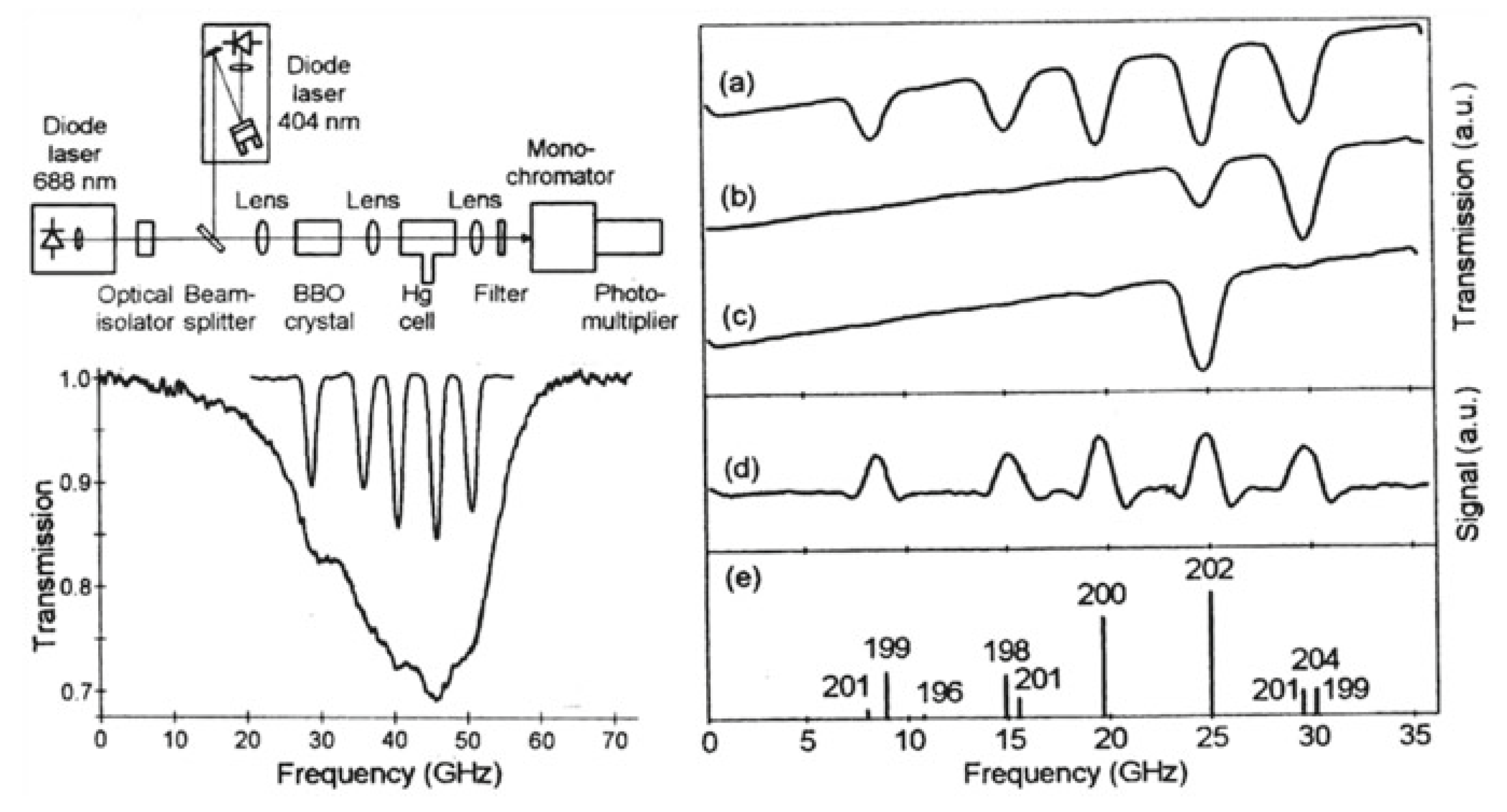
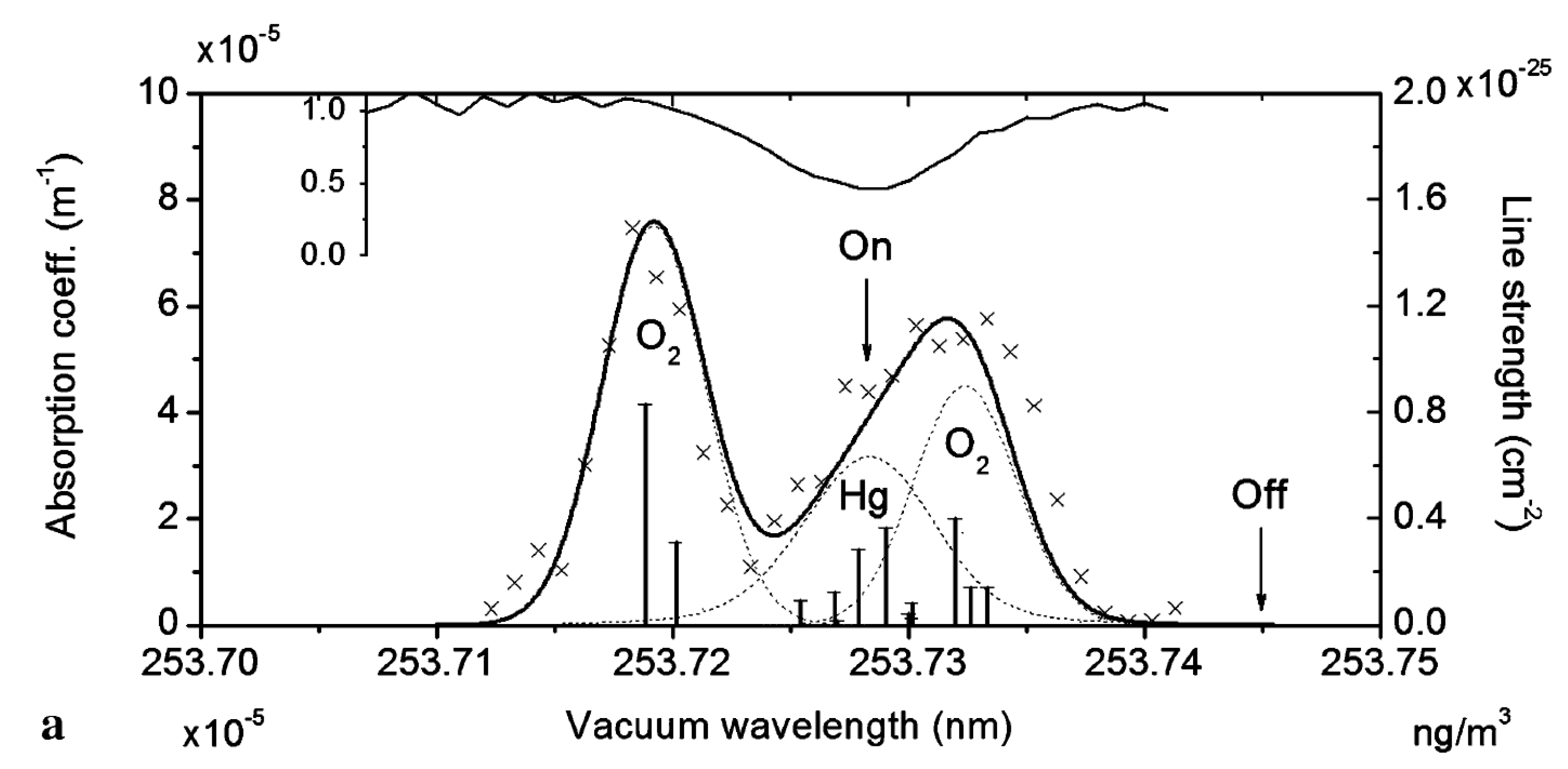
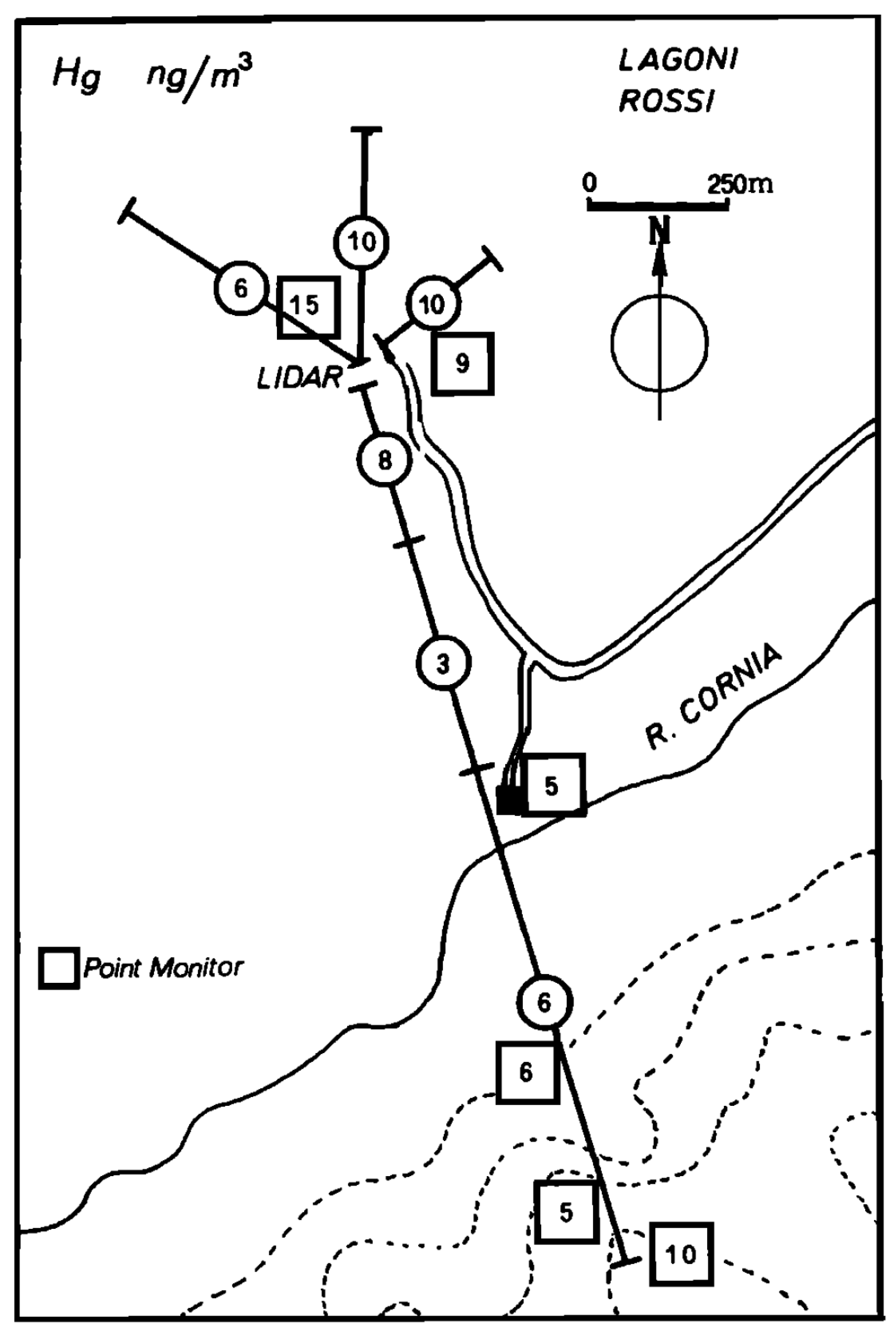

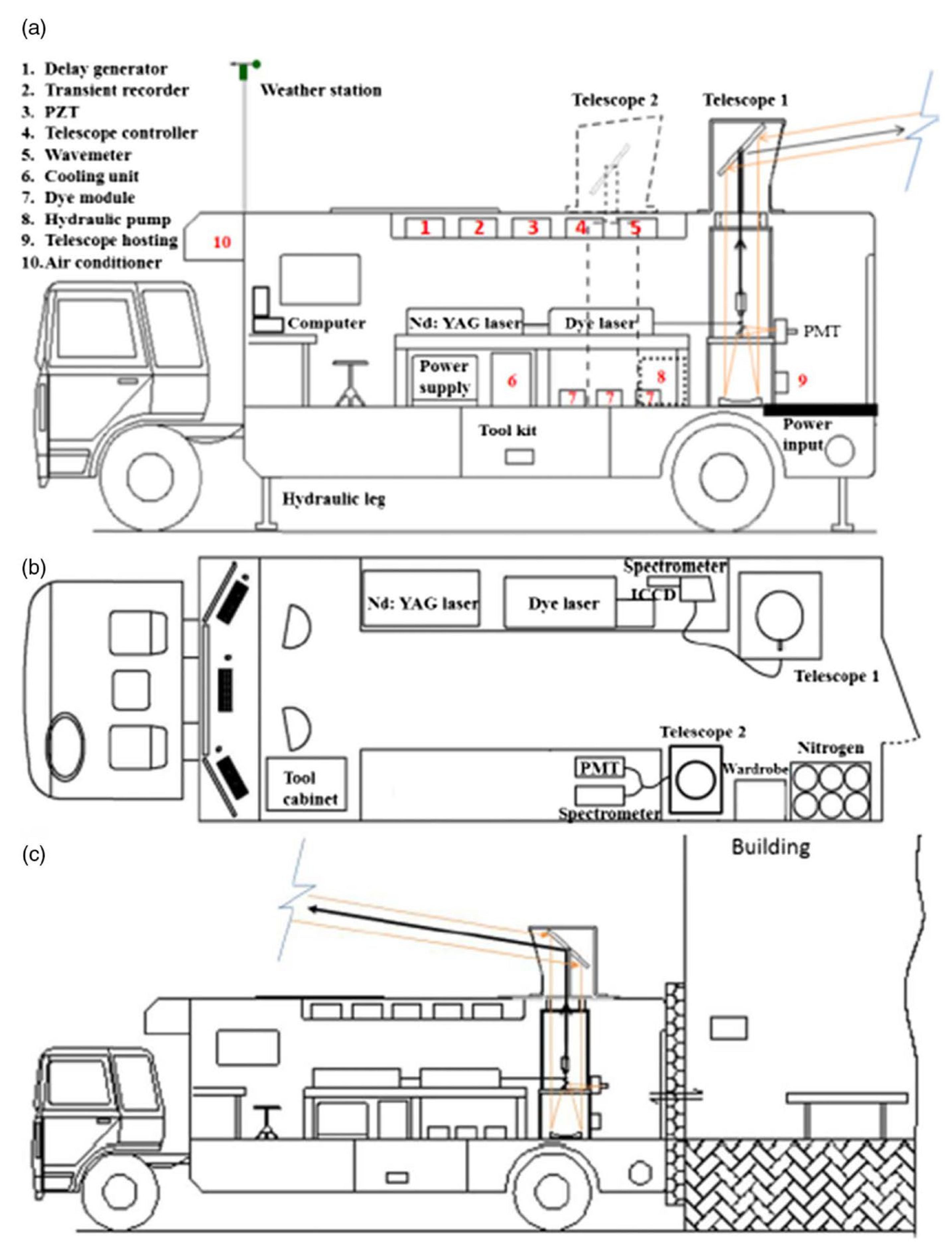

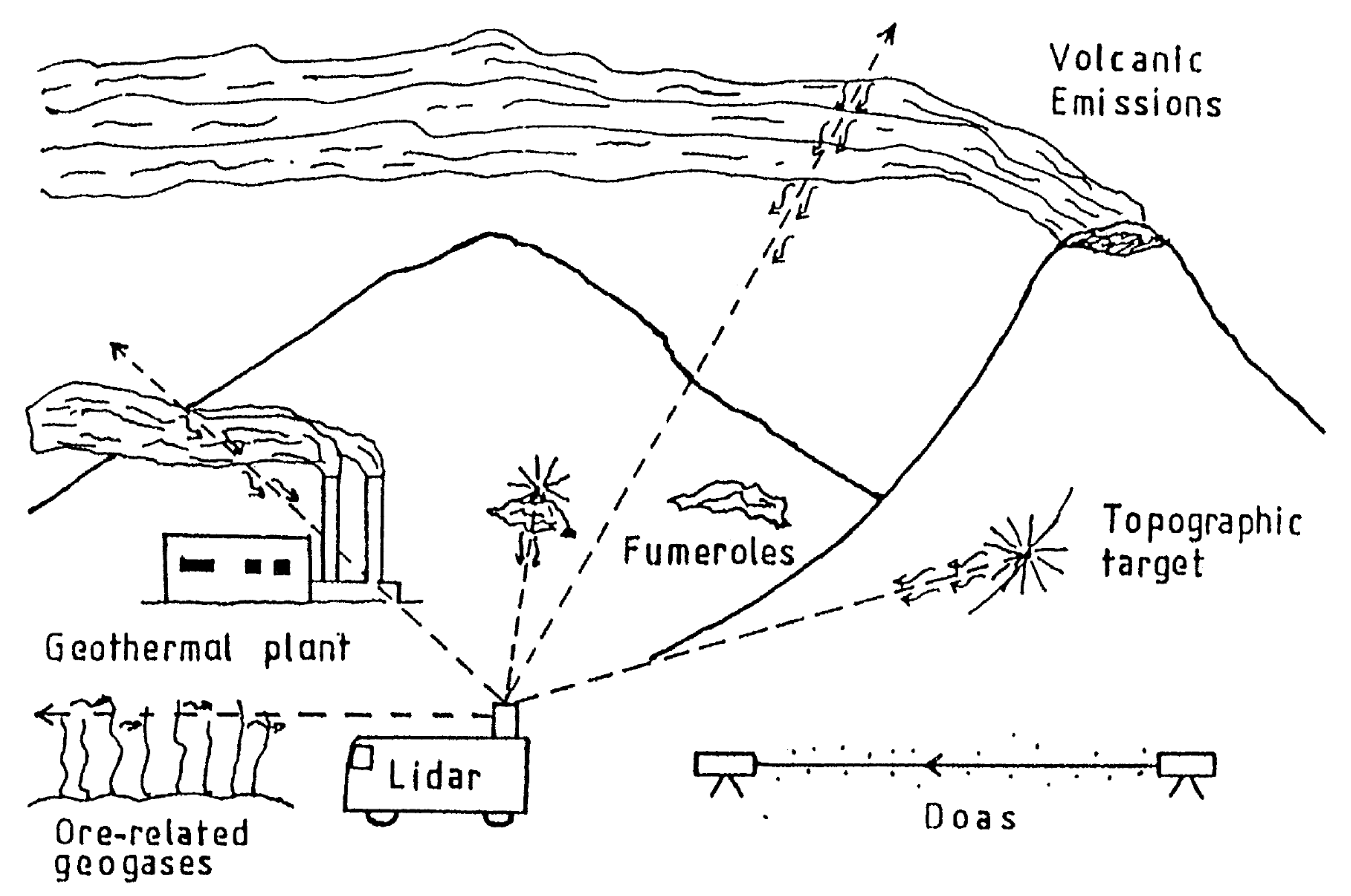
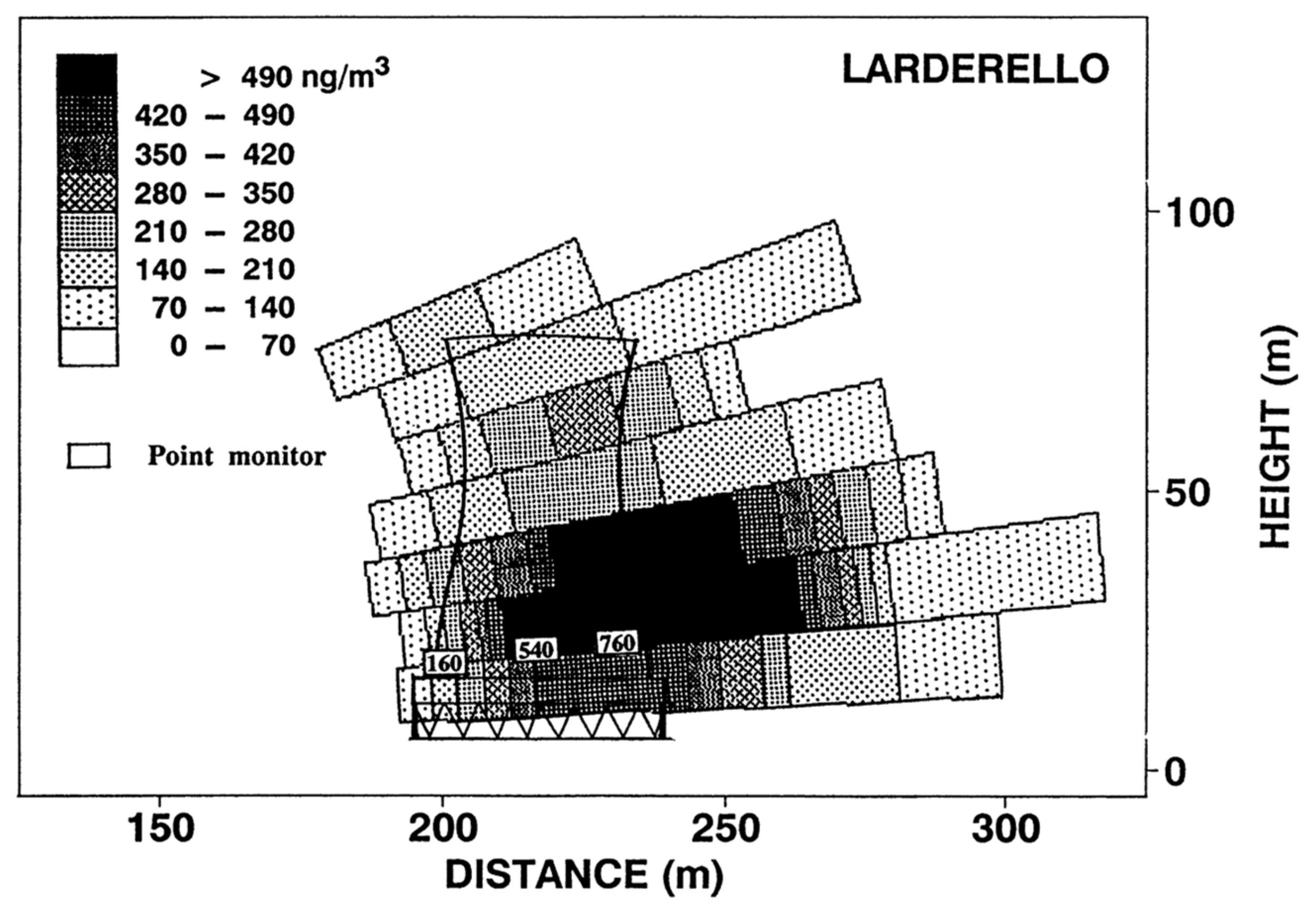


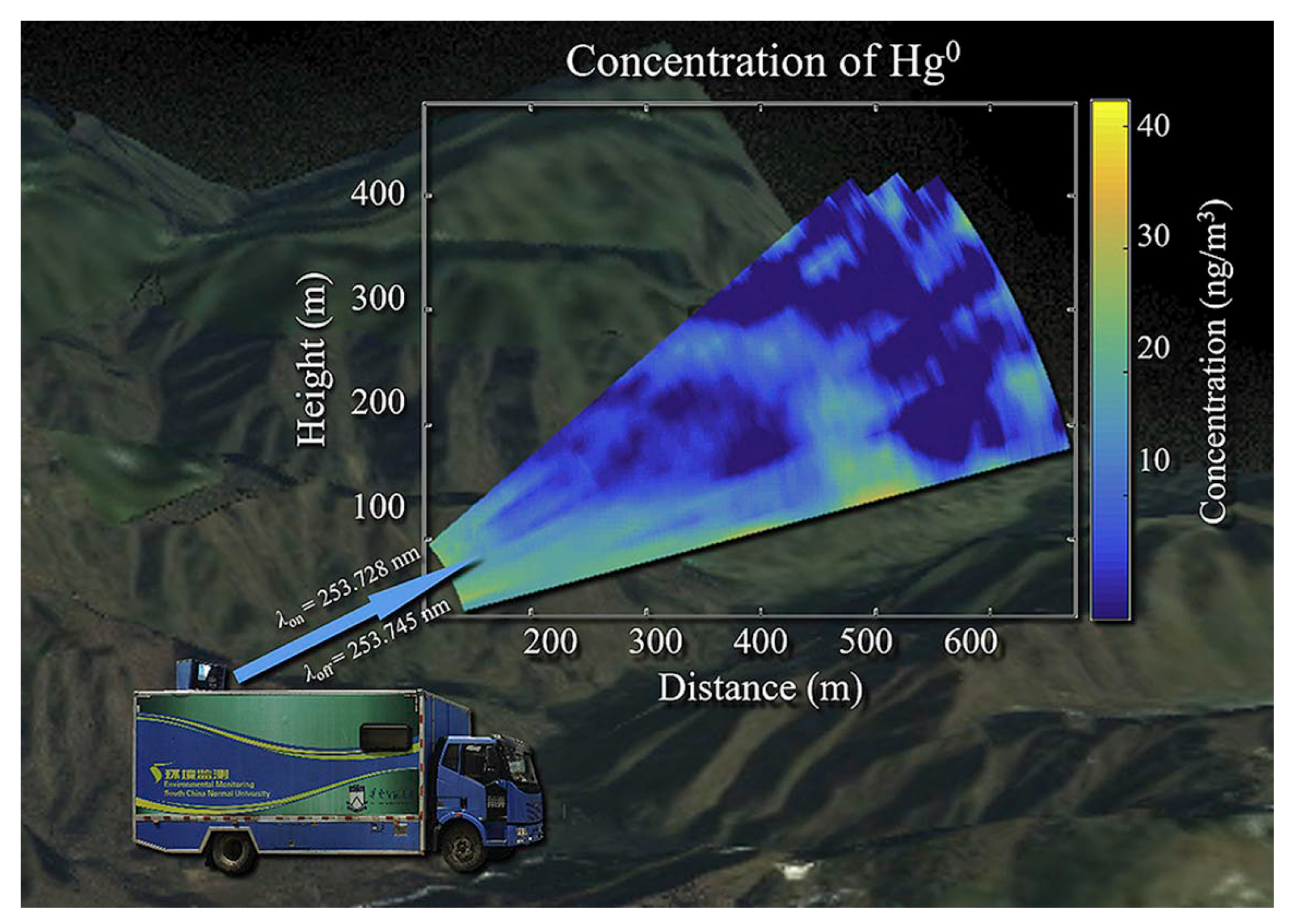
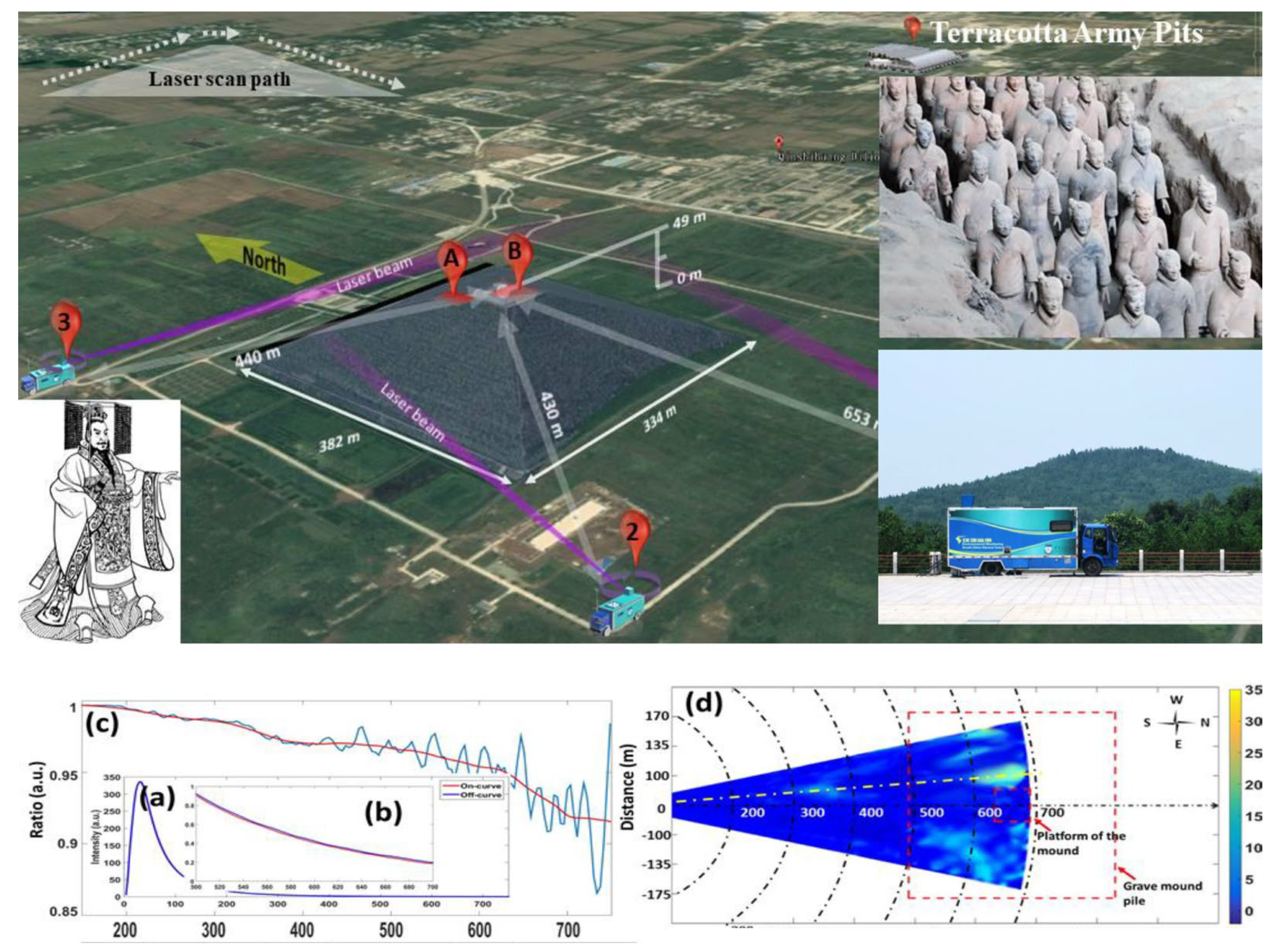
Disclaimer/Publisher’s Note: The statements, opinions and data contained in all publications are solely those of the individual author(s) and contributor(s) and not of MDPI and/or the editor(s). MDPI and/or the editor(s) disclaim responsibility for any injury to people or property resulting from any ideas, methods, instructions or products referred to in the content. |
© 2023 by the author. Licensee MDPI, Basel, Switzerland. This article is an open access article distributed under the terms and conditions of the Creative Commons Attribution (CC BY) license (https://creativecommons.org/licenses/by/4.0/).
Share and Cite
Svanberg, S. Monitoring Atmospheric Atomic Mercury by Optical Techniques. Atmosphere 2023, 14, 1124. https://doi.org/10.3390/atmos14071124
Svanberg S. Monitoring Atmospheric Atomic Mercury by Optical Techniques. Atmosphere. 2023; 14(7):1124. https://doi.org/10.3390/atmos14071124
Chicago/Turabian StyleSvanberg, Sune. 2023. "Monitoring Atmospheric Atomic Mercury by Optical Techniques" Atmosphere 14, no. 7: 1124. https://doi.org/10.3390/atmos14071124
APA StyleSvanberg, S. (2023). Monitoring Atmospheric Atomic Mercury by Optical Techniques. Atmosphere, 14(7), 1124. https://doi.org/10.3390/atmos14071124





